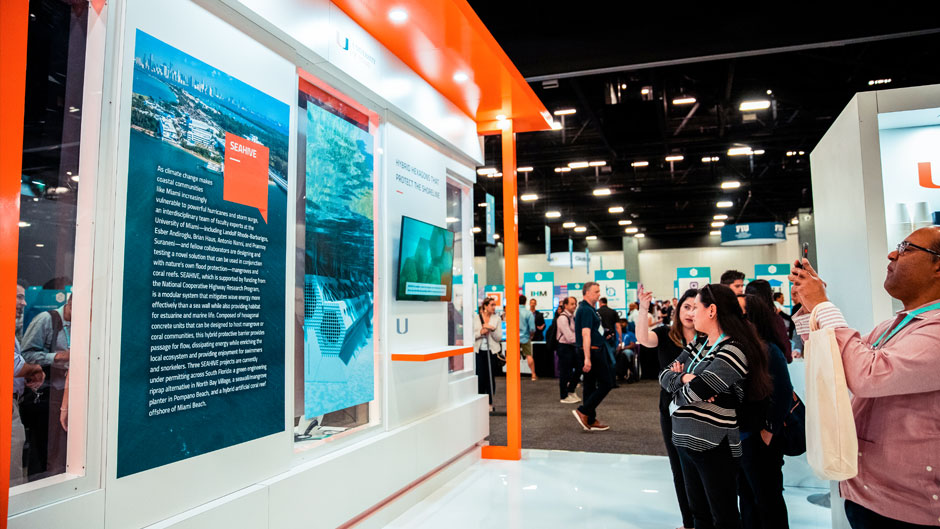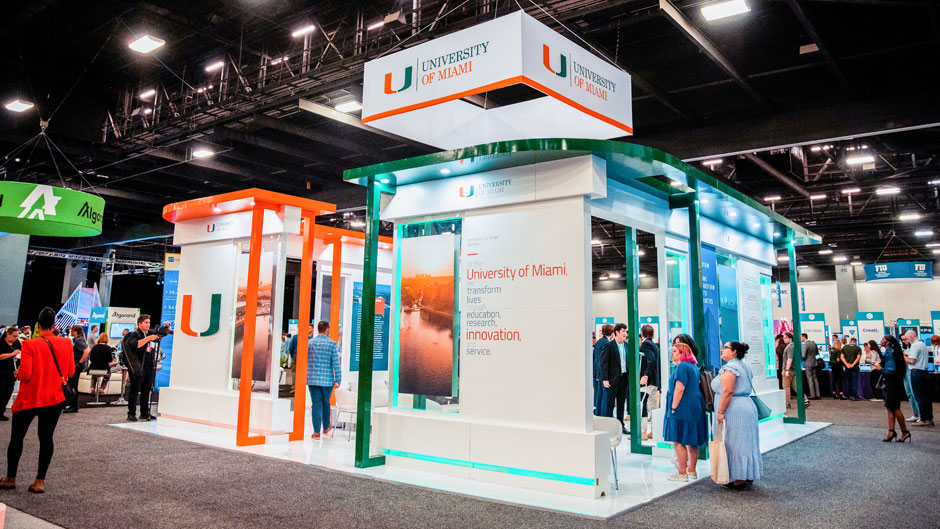Miami Beach residents have all the right reasons for wanting to protect their coastline from damaging storm surge.
When Hurricane Irma lashed Florida in 2017, it reshaped the city’s shoreline, washing away massive mounds of sand from a just-completed multimillion-dollar beach widening project.
And while Miami Beach recovered and has since been largely spared the most severe effects of a tropical storm, residents remain acutely aware that a powerful cyclone could one day inundate their city with devastating waves, creating an urban-climate double whammy for a municipality already dealing with sea level rise.
A new sustainable and eco-friendly seawall, which mimics the engineering skills of one of nature’s best-known plant pollinators, could be the solution Miami Beach and other coastal areas need to safeguard their neighborhoods and infrastructure from crashing waves.
Designed by a team of University of Miami engineers, SEAHIVE incorporates a tiered cement structure with beehive-shaped tubes that dissipate the energy of waves by allowing seawater to flow inside instead of being funneled downward, as is the case with conventional seawalls.
A miniature model of the structure, with its honeycomb-like design, played a starring role at the University’s exhibition space at this year’s eMerge Americas technology conference, which returned to the Miami Beach Convention Center for a two-day stint, April 18-19, after a two-year hiatus because of the pandemic.

“The hexagonal shape is the key to its success,” said Landolf Rhode-Barbarigos, an assistant professor of civil and architectural engineering in the College of Engineering and the lead principal investigator of SEAHIVE.
“We borrowed a page from nature and looked to bees, which are highly skilled architects and engineers,” he explained. “Like the hives they build, the hexagon shape we’ve employed in our design results in more volume for a given amount of material, and it allows us to stack and interlock elements of the structure in a highly efficient manner.”
A sloped layer of angular stones, known as riprap, is sometimes placed at the foot of vertical seawalls to augment protection from waves. SEAHIVE replaces those boulders. And it is that efficient use of space, combined with sustainable construction materials, that could make the structure the future of seawalls.
“So far, we haven’t seen any other system that brings all these integrated elements together,” said Rhode-Barbarigos, who holds secondary appointment at the Rosenstiel School of Marine and Atmospheric Science.
He and his team of researchers, which includes Ph.D. student Mohammad Ghiasian, designed the structure not only to dissipate a wave’s power but also to be biocompatible and eco-friendly to the marine environment—a characteristic traditional seawalls often lack.
While conventional seawalls may protect land, they can be detrimental to many species of marine life, taking away feeding and protection areas once provided by the mangroves and salt marshes they replace, said SEAHIVE team member Rafael Araujo, a senior research associate in marine biology and ecology at the Rosenstiel School.
And in the case of some vertical seawalls, wave energy is deflected downward, disturbing benthic marine organisms and impeding the growth of seagrasses, corals, or phytoplankton.
That is why the SEAHIVE team is experimenting with planting mangroves and coral on the structure, creating what Araujo calls a “greenbelt” that will attract marine life. “The goal,” he said, “is to have a system that will not only protect from flooding and erosion but will also be living EcoParks accessible to the public and that will educate our community about our rich marine life and unique ecosystems.”
“It’s long past the time that we start looking at building seawalls in a new way, and SEAHIVE helps serve that purpose,” said Esber Andiroglu, an associate professor of practice in the Department of Civil and Architectural Engineering in the College of Engineering, who is part of the SEAHIVE development team.
When placed inside the Rosenstiel School’s 38,000-gallon SUSTAIN wind-wave tank, models of the SEAHIVE structure performed well, absorbing more wave energy than a traditional seawall would, said Brian Haus, professor and chair of ocean sciences at the Rosenstiel School and director of the SUSTAIN Laboratory.
Now, all that awaits is deployment of the full-scale structures at three South Florida pilot locations. One will be in Miami Beach, where it will be installed as an offshore artificial reef. Another will be set up in North Bay Village as a 4- to 6-foot section to an existing seawall constructed last year using glass fiber-reinforced polymer rods. A third will be installed in Pompano Beach at a new underwater marine park called Wahoo Bay.
In Pompano Beach, Arthur C.R. Gleason, research associate professor of physics in the College of Arts and Sciences, and Ryan Fochs, a Ph.D. student at the Rosenstiel School, are using drones to photograph and map the Wahoo Bay site, stitching the images together to create a 3-D model of the inlet. The first flights got underway this month.
“We’ll do a second set just after the construction to get a before-and-after view,” Gleason stated. “Ideally, this will continue annually to build up a time series from which we can evaluate the efficacy of the installation.”
A special concrete mixture, still in the process of being perfected, will help ensure that SEAHIVE walls have a low carbon footprint, are not damaged easily, are able to repair themselves should they sustain damage, and will be friendly to marine life.
“Sustainability will be ensued by using high volumes of low-carbon cement substitutes, and typically, mixtures with high-volume cement substitutes should also be durable,” explained Prannoy Suraneni, assistant professor of civil and architectural engineering.
“High-performance, ultra-high performance, and self-healing concretes are being explored for durability and resilience,” Suraneni added. “For biocompatibility, we will deploy and monitor concrete compositions, including those with surface texture, to evaluate how concrete composition affects its attractiveness to marine life.”
Additionally, composite materials will replace steel reinforcement, ensuring that the concrete will not corrode, according to Antonio Nanni, professor and chair of the Department of Civil, Architectural, and Environmental Engineering.
“With the right type of design features, we believe we can create a seawall that’s eco-friendly and versatile enough to be installed in coastal communities around the world,” said Rhode-Barbarigos.
Drones to aid in recovery
Decimated by Hurricane Maria in 2017, Puerto Rico’s El Yunque National Forest is once again green, new leaves and flowering plants having replaced the foliage that had turned brown and muddied by a Category 5 storm.
For the rainforest’s main roads, however, recovery has been a slow process, with some still compromised and susceptible to landslides nearly five years after Hurricane Maria drenched the surrounding soil with torrential rains.
But using a fixed-wing drone capable of reaching altitudes of 5,000 feet, a University of Miami student and two recent graduates recently mapped El Yunque’s network of roads, turning their images and data over to a construction firm that has relied on the information to help reinforce those thoroughfares.
Benjamin Kling, Alexander Leiva, and Whitaker Redgate’s drone-mapping efforts are part of Precision Ecology, a remote-sensing and data venture they started two years ago to create digital surface and terrain maps for clients engaged in sustainable development, environmental conservation, and agriculture.
The orange-colored drone that mapped El Yunque’s main roads, allowing crews to make those passageways safer, was prominently displayed at the University’s eMerge America’s exhibition space on Monday.
“Before we even arrived in Puerto Rico a year ago, we knew that it was dangerous to travel along some of El Yunque’s roads. Some were still inaccessible,” said Leiva, Precision Ecology’s drone pilot. “We demonstrated our company’s value because normal survey crews that would normally go on foot to survey those roads couldn’t even reach them. But with our drones, what would have taken ground crews months to do, we were able to accomplish in a matter of days.” Five, as a matter of fact.
The team conducted a similar aerial-mapping project in St. Croix in the U.S. Virgin Islands, mapping 13,000 acres in just six days and providing the data to government officials, who will use it in their road improvement projects.
Now, they have their sights set on expanding their fleet of three drones. “Our ultimate goal is to decentralize. And rather than ourselves having all of the drones, have a system that connects the drones and the people who operate them,” Kling said.
Among the other endeavors and displays featured at the University of Miami’s eMerge Americas exhibition area were the following:
- Goggles developed by Bascom Palmer Eye Institute ophthalmologist Mohamed Abou Shousha that can detect eye diseases such as glaucoma and age-related macular degeneration were showcased. “They have a 98 percent reliability in diagnosing conditions, which is the gold standard of visual field testing,” said Christian Duque, clinical application specialist for Miami-based Heru, a Bascom Palmer spinoff that develops wearable AI-powered vision diagnostics.
The goggles, which are now in use at clinics and hospitals in all 50 states, are being further developed to help patients with eye diseases to see better. “For patients with glaucoma or any other peripheral disease, they only have an island of visual field, meaning they only see through a donut hole,” Duque explained. “But our goal is to place these goggles on a patient to give them a full fish-eye view of their peripheral vision within that island of view.”
- A display featured biographies of “Women in Technology at the U,” such as Niani Mays, a biomedical engineering major and the president of the University’s chapter of the National Society of Black Engineers, who conducts research on biomaterials and tissue engineering.
- UInnovation programs like the ’Cane Angel Network, which unites entrepreneurs and investors from the University community to provide startups with early-stage funding and a network of advisors, were highlighted.
- And the William H. Coulter Center for Translational Research at the Miller School of Medicine was spotlighted. It cultivates practical applications of biomedical and bioengineering research to create products and procedures that will have a positive impact on public health.

